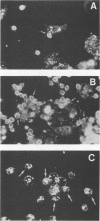Abstract
The adherence of Trichomonas vaginalis NYH 286 to host cells was evaluated by using monolayer cultures of HeLa and HEp-2 epithelial cells and human fibroblast cell lines. Saturation of sites on HeLa cells was achieved, yielding a maximal T. vaginalis NYH 286-to-cell ratio of two. The ability of radiolabeled NYH 286 to compete with unlabeled trichomonads for attachment and the time, temperature, and pH-dependent nature of host cell parasitism reinforced the idea of specific parasite-cell associations. Other trichomonal isolates (JH31A, RU375, and JHHR) were also found to adhere to cell monolayers, albeit to different degrees, and all isolates produced maximal contact-dependent HeLa cell cytotoxicity. The avirulent trichomonad, Trichomonas tenax, did not adhere to cell monolayers and did not cause host cell damage. Interestingly, parasite cytadherence was greater with HeLa and HEp-2 epithelial cells than with fibroblast cells. In addition, cytotoxicity with fibroblast cells never exceeded 20% of the level of cell killing observed for epithelial cells. Elucidation of properties of the pathogenic human trichomonads that allowed for host cell surface parasitism was also attempted. Treatment of motile T. vaginalis NYH 286 with trypsin diminished cell parasitism. Incubation of trypsinized organisms in growth medium allowed for regeneration of trichomonal adherence, and cycloheximide inhibited the regeneration of attachment. Organisms poisoned with metronidazole or iodoacetate failed to attach to host cells, and adherent trichomonads exposed to metronidazole or iodoacetate were readily released from parasitized cells. Coincubation experiments with polycationic proteins and sugars and pretreatment of parasites or cells with neuraminidase or periodate had no effect on host cell parasitism. Colchicine and cytochalasin B, however, did produce some inhibition of adherence to HeLa cells. The data suggest that metabolizing T. vaginalis adheres to host cells via parasite surface proteins in a specific receptor-ligand fashion. Furthermore, parasitism of epithelial cells appears to render this cell type more susceptible than fibroblast cell types to contact-dependent cytotoxicity.
Full text
PDF







Images in this article
Selected References
These references are in PubMed. This may not be the complete list of references from this article.
- Alderete J. F. Identification of immunogenic and antibody-binding membrane proteins of pathogenic Trichomonas vaginalis. Infect Immun. 1983 Apr;40(1):284–291. doi: 10.1128/iai.40.1.284-291.1983. [DOI] [PMC free article] [PubMed] [Google Scholar]
- Alderete J. F., Pearlman E. Pathogenic Trichomonas vaginalis cytotoxicity to cell culture monolayers. Br J Vener Dis. 1984 Apr;60(2):99–105. doi: 10.1136/sti.60.2.99. [DOI] [PMC free article] [PubMed] [Google Scholar]
- CHRISTIAN R. T., MILLER N. F., LUDOVICI P. P., RILEY G. M. A study of Trichomonas vaginalis in human cell culture. Am J Obstet Gynecol. 1963 Apr 1;85:947–954. doi: 10.1016/s0002-9378(16)35599-5. [DOI] [PubMed] [Google Scholar]
- Cappuccinelli P., Varesio L. The effect of cytochalasin B, colchicine and vinblastine on the adhesion of Trichomonas vaginalis to glass surfaces. Int J Parasitol. 1975 Feb;5(1):57–61. doi: 10.1016/0020-7519(75)90098-3. [DOI] [PubMed] [Google Scholar]
- Glasgow L. R., Hill R. L. Interaction of Mycoplasma gallisepticum with sialyl glycoproteins. Infect Immun. 1980 Nov;30(2):353–361. doi: 10.1128/iai.30.2.353-361.1980. [DOI] [PMC free article] [PubMed] [Google Scholar]
- Heath J. P. Behaviour and pathogenicity of Trichomonas vaginalis in epithelial cell cultures: a study by light and scanning electron microscopy. Br J Vener Dis. 1981 Apr;57(2):106–117. doi: 10.1136/sti.57.2.106. [DOI] [PMC free article] [PubMed] [Google Scholar]
- Kuczyńska K., Choromański L., Honigberg B. M. Comparison of virulence of clones of two Trichomonas vaginalis strains by the subcutaneous mouse assay. Z Parasitenkd. 1984;70(2):141–146. doi: 10.1007/BF00942215. [DOI] [PubMed] [Google Scholar]
- Kulda J., Honigberg B. M. Behavior and pathogenicity of Tritrichomonas foetus in chick liver cell cultures. J Protozool. 1969 Aug;16(3):479–495. doi: 10.1111/j.1550-7408.1969.tb02304.x. [DOI] [PubMed] [Google Scholar]
- Lindmark D. G., Müller M. Antitrichomonad action, mutagenicity, and reduction of metronidazole and other nitroimidazoles. Antimicrob Agents Chemother. 1976 Sep;10(3):476–482. doi: 10.1128/aac.10.3.476. [DOI] [PMC free article] [PubMed] [Google Scholar]
- Müller M., Gorrell T. E. Metabolism and metronidazole uptake in Trichomonas vaginalis isolates with different metronidazole susceptibilities. Antimicrob Agents Chemother. 1983 Nov;24(5):667–673. doi: 10.1128/aac.24.5.667. [DOI] [PMC free article] [PubMed] [Google Scholar]
- Nielsen M. H., Nielsen R. Electron microscopy of Trichomonas vaginalis Donné: interaction with vaginal epithelium in human trichomoniasis. Acta Pathol Microbiol Scand B. 1975 Aug;83(4):305–320. doi: 10.1111/j.1699-0463.1975.tb00107.x. [DOI] [PubMed] [Google Scholar]
- Peterson K. M., Alderete J. F. Iron uptake and increased intracellular enzyme activity follow host lactoferrin binding by Trichomonas vaginalis receptors. J Exp Med. 1984 Aug 1;160(2):398–410. doi: 10.1084/jem.160.2.398. [DOI] [PMC free article] [PubMed] [Google Scholar]
- Peterson K. M., Alderete J. F. Selective acquisition of plasma proteins by Trichomonas vaginalis and human lipoproteins as a growth requirement for this species. Mol Biochem Parasitol. 1984 May;12(1):37–48. doi: 10.1016/0166-6851(84)90042-2. [DOI] [PubMed] [Google Scholar]
- Peterson K. M., Alderete J. F. Trichomonas vaginalis is dependent on uptake and degradation of human low density lipoproteins. J Exp Med. 1984 Nov 1;160(5):1261–1272. doi: 10.1084/jem.160.5.1261. [DOI] [PMC free article] [PubMed] [Google Scholar]
- Wartoń A., Honigberg B. M. Analysis of surface saccharides in Trichomonas vaginalis strains with various pathogenicity levels by fluorescein-conjugated plant lectins. Z Parasitenkd. 1983;69(2):149–159. doi: 10.1007/BF00926951. [DOI] [PubMed] [Google Scholar]
- Werk R., Dunker R., Fischer S. Polycationic polypeptides: a possible model for the penetration-enhancing factor in the invasion of host cells by Toxoplasma gondii. J Gen Microbiol. 1984 Apr;130(4):927–933. doi: 10.1099/00221287-130-4-927. [DOI] [PubMed] [Google Scholar]



